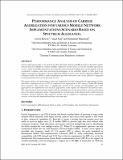Performance analysis of carrier aggregation for various mobile network implementations scenario based on spectrum allocated

View/
Date
2017-10Author
Kiwoli, Liston
Sam, Anael E.
Manasseh, Emmanuel
Metadata
Show full item recordAbstract
Carrier Aggregation (CA) is one of the Long Term Evolution Advanced (LTE-A) features that allow mobile
network operators (MNO) to combine multiple component carriers (CCs) across the available spectrum to
create a wider bandwidth channel for increasing the network data throughput and overall capacity. CA has
a potential to enhance data rates and network performance in the downlink, uplink, or both, and it can
support aggregation of frequency division duplexing (FDD) as well as time division duplexing (TDD). The
technique enables the MNO to exploit fragmented spectrum allocations and can be utilized to aggregate
licensed and unlicensed carrier spectrum as well.
This paper analyzes the performance gains and complexity level that arises from the aggregation of three
inter-band component carriers (3CC) as compared to the aggregation of 2CC using a Vienna LTE System
Level simulator. The results show a considerable growth in the average cell throughput when 3CC
aggregations are implemented over the 2CC aggregation, at the expense of reduction in the fairness index.
The reduction in the fairness index implies that, the scheduler has an increased task in resource allocations
due to the added component carrier. Compensating for such decrease in the fairness index could result into
scheduler design complexity. The proposed scheme can be adopted in combining various component
carriers, to increase the bandwidth and hence the data rates.
URI
https://aircconline.com/ijwmn/V9N5/9517ijwmn05.pdfhttp://dspace.nm-aist.ac.tz/handle/123456789/134
